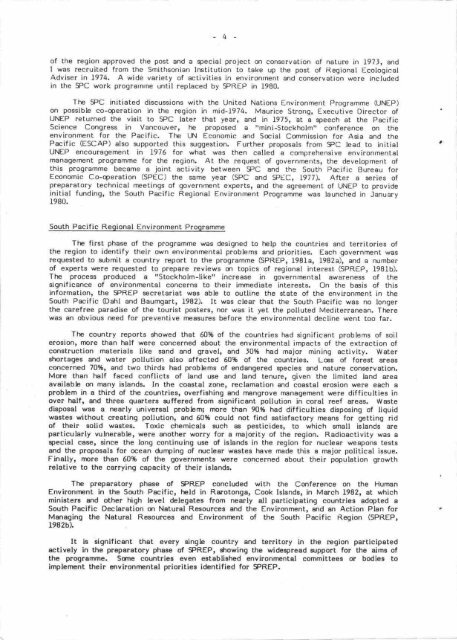Rt€@lll
Rt€@lll
Rt€@lll
You also want an ePaper? Increase the reach of your titles
YUMPU automatically turns print PDFs into web optimized ePapers that Google loves.
-4<br />
of the region approved lhe posl and a special project on conservation of nature in J.97J, and<br />
I was recruited from the Smithsonian Institution to take up the post of Regional Llcologieal<br />
Adviser in L974. A wide variety of acLivities in environrnent and conservation were included<br />
in the SPC work prollrarnrne until replaced by SPREP in 1980.<br />
The SPC initialed discussions with the United Nations Environment Programme (UNEP)<br />
on possible co-operation in the region in mid-1974. Maurice Strong, Executi ve Director of<br />
UNEP returned the visit to SPC laten that year, and in 1975, 'aL a speech at the Pacific<br />
Science Congress in Vaneouver, he proposed a "mini-stockholm" conference on the<br />
environmenL for the Pacific. The LJN Economic and Scial Cornmission fon Asia and the<br />
Pacific (ESCAP) also zupported this zuggestion. Further proposals from SPC lead to initial<br />
UNEP encouragement in L976 for what was then called a comprehensi ve environmenlal<br />
management programme for the region. At the request of governments, the development of<br />
this programme became a joint activity between SPC and the Soulh Paclfic Bureau for<br />
Economic Co-operation (SPEC) the same year (SPC and SPEC, L977). After a series of<br />
preparatory technical meetings of government experts, and the agreement of UNEP to provide<br />
initial funding, the South Pacific Regional Environnrent Programme was launched in January<br />
I980.<br />
South Pacific Reqional Environment Proqramme<br />
The first phase of the pnogramme was designed to help the countries and territories of<br />
the region to identify their own environrnental problems and priorities. Each government was<br />
nequested Lo submit a country r€port to the programme (SPREP, l98la, 1982a), and a numben<br />
of experts were requested to prepare reviews m topics of regional interest (SPREP, l98lb).<br />
The process produced a "Stockholm-like" increase in governmental awareness of the<br />
significance of environmental concerns to their immediate interests. On the basis of this<br />
information' the SPREP secretariat was able to outline the state of the environment in the<br />
South Pacific (Dahl and Baumgart, 1982). It was clear that the South Pacific was no longen<br />
the carefree paradise of the tourist posters, nor was it yet the polluted Mediterranean. There<br />
was an obvious need for preventive measures befone the environmental decline went too far.<br />
The country reports showed that 60% of the countries had significant problems of soil<br />
erosion, more than half were concerned about the environmental impacts of the exLraction of<br />
construction materials like sand and gravel, and l0% had major mining activity. W at,er<br />
shorteges and water pollution also affected 60% of the countries. Lcs of forest areas<br />
concerned 70%, and two thirds had problems of endangered species and nature conservation.<br />
More than half faced conflicts of land use and land tenure, given the limited land area<br />
available m many islands. In the coastal zone, reclamation and coastal erosion were each a<br />
problem in a third of the countries, overfishing and mangrove rnanagement were difficulties in<br />
over half, and three querters s.rffered from significant pollution in coral reef areas. Waste<br />
disposal was a nearly universal problem; more than 9096 had difficulties disposing of liquid<br />
wasteg without creating pollution, and 50% could not find satisfactory npans for getting rid<br />
of their eolid wastes. Toxic chemicals sueh as pesticides, to which small islands are<br />
particularly wlnerable, were another worry for a majority of the region. Radioactivity was a<br />
special case, since the long continuing use of islends in the region for nuclear weapons tests<br />
and the proposals for ocean drmping of nuclear wastes have made this a major political issue.<br />
Finallyr npre than 60% of the governments were concerned about their population growth<br />
relative to the carrying capacity of their islands.<br />
The preparatory phase of SPREP eoncluded with the Conference on the Human<br />
Environment in the South Paeific, held in Rarotonga, Cook Islands, in March 1982, at which<br />
ministers and other high level delegates from nearly all participeting countries adopted a<br />
South Pacific Declaretion m Natural Resourceg and the Environment, and an Action Plan for<br />
Managing the Natural Resources and Environrnent of the South Pacific Region (SPREP,<br />
1982b).<br />
It is significant that every single country and territory in the region participated<br />
aetively in the preparatory phase of SPREP, *rowing the widespread support for the eims of<br />
the progremme. Ssne eountriee even egtebliehed environmental committees or bodies to<br />
implennnt their environrnental priorities identified for SPREP.














![R]€@lll](https://img.yumpu.com/7594335/1/175x260/reurlll.jpg?quality=85)
